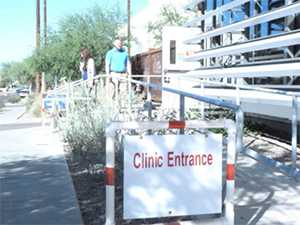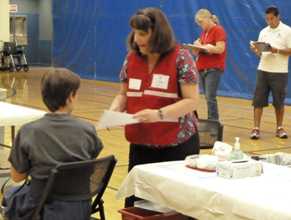2012 University of Arizona Campus Emergency Response Team: Flu Shot Clinic
 The University of Arizona (UA), has been working diligently since 2004 to develop mass clinic plans for public health emergencies requiring the distribution of vaccines and/or antibiotics to a large segment of the Tucson population including the university community. In accordance with our Intergovernmental Agreement (IGA) with the Pima County Health Department (PCHD), the University supports the PCHD in the distribution of public health interventions to the University population during a public health emergency. The university population includes UA students, employees, family members of employees, and community members falling within a catchment area of the university.
The University of Arizona (UA), has been working diligently since 2004 to develop mass clinic plans for public health emergencies requiring the distribution of vaccines and/or antibiotics to a large segment of the Tucson population including the university community. In accordance with our Intergovernmental Agreement (IGA) with the Pima County Health Department (PCHD), the University supports the PCHD in the distribution of public health interventions to the University population during a public health emergency. The university population includes UA students, employees, family members of employees, and community members falling within a catchment area of the university.
The UA Mass Clinic Planning Group developed a Walk-Up Point of Distribution (POD) plan for utilization in the event of a public health emergency requiring the distribution of vaccine or antibiotics to the public. The UA conducted a seasonal influenza walk-up exercise on October 13, 2012 to test the Mass Prophylaxis and Volunteer and Donations Management capabilities essential to the walk-up POD plans. .
The objectives of this exercise were as follows:
- Implement the UA Walk-Up POD Plan to stand up a POD at the Campus Recreation Center.
- Administer 300 vaccines to the UA community (including students, staff, faculty and family members over the age of 18) in 3 hours.
- Evaluate online volunteer registration and management system.
- Activate the Incident Command Post (ICP) to support POD Operations and train all staff (ICP and POD leadership) on plans and procedures.
- Ensure that all POD Staff has received their vaccination prior to the exercise.
 During this event, we were able to test the efficacy of a walk-up POD held in the Campus Recreation Center, evaluate our online volunteer recruitment and registration plan, stand up an Emergency Operations Center (EOC) to support POD Operations, and conduct a time study to determine POD throughput, all while providing an essential service to our community.
During this event, we were able to test the efficacy of a walk-up POD held in the Campus Recreation Center, evaluate our online volunteer recruitment and registration plan, stand up an Emergency Operations Center (EOC) to support POD Operations, and conduct a time study to determine POD throughput, all while providing an essential service to our community.
As this initiative is not part of a funding deliverable for the University, a key challenge was pulling together the necessary resources and funding to carry out the exercise. Financial support from the UA CERT as well as collaboration with the campus community, including Campus Health Services, Police Department, Campus Recreation Center, Office of Risk Management, and Parking & Transportation, made this event possible.
Staff member of MWPERLC, Mona Arora, serves as the Chair of the Planning Group and provided exercise design and evaluation guidance for the exercise. The MWPERLC was able to successfully implement and evaluate the UA walk-up POD plan while training personnel on key aspects of the plan. In addition, we were able to capture quality feedback from all levels of participants through the implementation of client feedback surveys as well as introduction of actors into the clinic to evaluate levels and quality of response provided. The latter also enabled us to conduct a time study to calculate the throughput of the POD. All of these efforts combined have enhanced the University of Arizona’s capability to respond to a public health emergency requiring implementation of mass vaccination or prophylaxis interventions.
- Page last reviewed: April 10, 2015
- Page last updated: April 10, 2015
- Content source:


 ShareCompartir
ShareCompartir